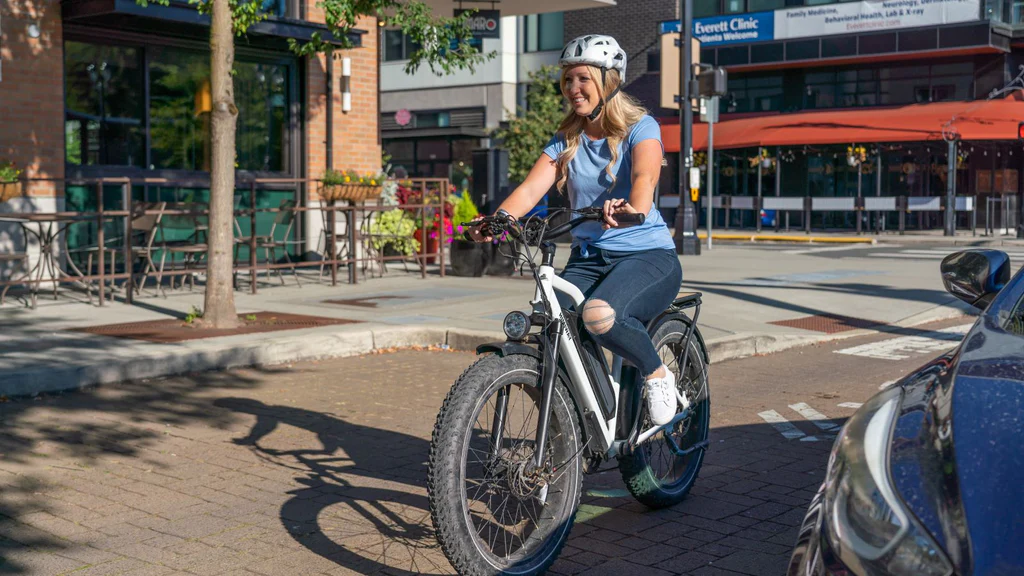Let’s be honest. Knee surgery is no fun, but sometimes it is necessary. As one of our most critical joints, the knee joint is prone to all sorts of issues and maladies, especially as we age. Our knees do a lot of work and take on a lot of the stress we put our bodies through. With high-impact sports and strenuous day-to-day activity, the knee is a hotspot for required surgeries and replacements.
Whether you need a total knee replacement, often abbreviated as TKR, or you simply had a knee arthroscopy to inspect your knee quality, it may be intimidating or impossible to jump back into your old routine and get the benefits of cycling 30 minutes per day. This is where slow and steady wins the race. And you can’t go wrong by adding another tool to your repertoire – the e-bike. One of the most common methods people choose to begin exercising again after a knee surgery is to use an electric bike, for many reasons we will discuss.

Ask Your Doctor Before E-biking After Knee Surgery
No matter which procedure you had performed, it is best to set up a recovery plan with your doctor. Only a licensed professional can tell you when and how much you can exercise again after the surgery and much of the plan will depend on how you progress which you won’t know until you start. The good news is that millions of people around the world have had knee surgeries and made full recoveries.
The two most important aspects to recovering from knee surgery are patience and perseverance. You must let your knee heal. You will only delay your recovery and increase your pain or risk of damaging the knee again if you try to push yourself too hard too fast. We will cover the perseverance component in the next section when we discuss physical therapy on the road to recovery. Check with your doctor if you experience any additional injuries while cycling.
The Steps to Getting Back on a Bike
There are three core steps to getting back on a bike after knee surgery. Those three steps are professional physical therapy, stationary riding, and finally, outdoor riding on your bike.
Physical therapy gives you back your range of motion (often abbreviated as ROM). As the knee heals, various motions are needed to allow it to settle and conform back to its proper role within your body. Physical therapy encourages you to move again under the proper guidance of a trained professional. It builds strength around your knee to protect it.
After physical therapy, or in the later stages of it for some people, indoor stationary riding becomes possible. You won’t have as much balance at first which is why a sturdy and stationary bike is ideal. This may occur under the watch of a therapist or at an indoor gym. Light pedaling will help ensure you don’t over-exert yourself at first. Set the seat to a height which just barely allows your feet to rest on the pedals with a minor bend to your knee joint. As you return over the days and weeks, you can slowly increase the intensity or resistance of the stationary bike.
Once you have been cleared by a doctor or physical therapist to return to outdoor riding, you can utilize an e-bike with a high level of pedal assist to try it out. This low-impact cardio will feel great after months of not being able to ride outdoors and is well worth the wait. Do not attempt to ride on any dirt or uneven trails at first. Stick to the flat, paved ground at first.
This methodical approach to getting back on the bike has been proven time and time again. Don’t rush it. Building up strength in both legs will happen during physical therapy. Regaining control of your balance will help during physical therapy as well. Getting your confidence back will occur on the stationary bike. And riding outdoors will be a great reward for all your efforts.
Warm Up and Stretch
Once you’ve regained total control and range of motion of your knees, you’ll want to keep it. Daily stretching is important, not just stretching before you work out. Warm up before any cardio by moving around in general. Try air squats with just your body weight, high kicks, or lunges. Don’t forget to warm up your hips because one leg is going to be stronger than your other at first and may need extra stretching. Do an easy lap around the neighborhood before attempting any long rides. Yoga or beginner Zoomba can be a great way to raise your heart rate and get the blood flowing through your body to preparefor a ride.

Which Model is Best for E-biking After Knee Surgery?
We know how to get back into the saddle after knee surgery, but which e-bike is best to use for such a pursuit? In our experience, a moped-style step-thru model such as the EzeBike Escape or EzeBike Big Dog is the safest and easiest bike to use post-surgery. The low entry point provides an easy way to get on the bike without lifting or bending your leg as much. And because your balance may still be compromised, the easier it is to get on the bike, the better. We’ve compared Step-Thru Cargo ebikes before and concluded the EzeBike Big Dog is the best choice for most riders.
Other EzeBike e-bike models offer a step-thru frame, but the high payload capacity and dual suspension of the Escape ensure you can carry any number of items and extra weight with you and still achieve maximum comfort.
A momentary setback such as knee surgery is no reason to give up hope. By following these tried-and-true tips, you will be back on your e bike in no time. Remember to follow the doctor’s orders as it pertains to your recovery schedule and check in with them if you experience any unusual pain or discomfort. Attend all physical therapy sessions and work with your therapist to regain mobility slowly. Use a stationary bike to get the feel for riding again and when you are ready, try an e-bike for its added benefits for knee surgery patients.
And if you have not had knee surgery yet, there are some great tips for protecting your knees when riding an electric bike that will keep you riding for as long as possible.